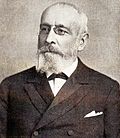Van Lynden van Sandenburg cabinet | |
|---|---|
| Cabinet of the Netherlands | |
| Date formed | 20 August 1879 |
| Date dissolved | 23 April 1883 (Demissionary from 1 March 1883) |
| People and organisations | |
| Head of state | King William III |
| Head of government | Theo van Lynden van Sandenburg |
| No. of ministers | 8 |
| Ministers removed | 4 |
| Total no. of members | 11 |
| Member party | Independent Conservatives (Ind. Con.) Independent Liberals (Ind. Lib.) Independent Catholics (Ind. Cat.) Independent Protestants (Ind. Prot.) |
| Status in legislature | Centre-right Majority government |
| History | |
| Election | 1879 election |
| Outgoing election | 1883 election |
| Legislature terms | 1879–1883 |
| Predecessor | Kappeyne van de Coppello cabinet |
| Successor | J. Heemskerk cabinet |
| Part of the Politics series |
 |
|---|
| |
The Van Lynden van Sandenburg cabinet was the cabinet of the Netherlands from 20 August 1879 until 23 April 1883. The cabinet was formed by Independent Conservatives (Ind. Con.), Independent Liberals (Ind. Lib.), Independent Catholics (Ind. Cat.) and Independent Protestants (Ind. Prot.) after the election of 1879. The centre-right cabinet was a majority government in the House of Representatives. Independent Protestant Christian Democrat Theo van Lynden van Sandenburg was Prime Minister.








